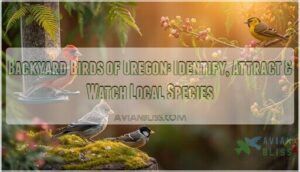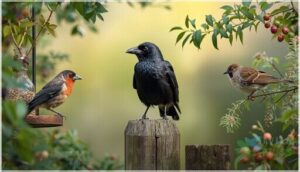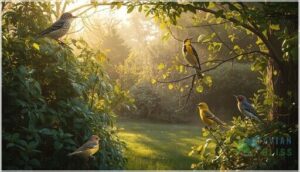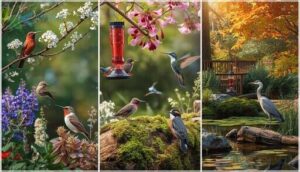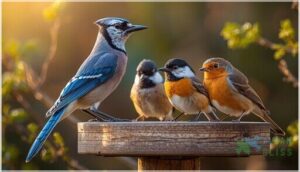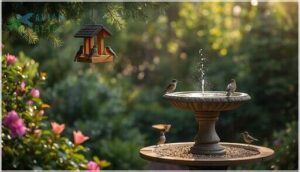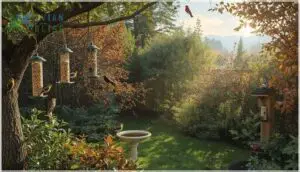This site is supported by our readers. We may earn a commission, at no cost to you, if you purchase through links.
Oregon’s backyards host an impressive parade of feathered visitors. House Finches dominate feeders year-round with over 133,000 sightings across the state. Dark-eyed Juncos flood in each winter by the thousands. Nashville Warblers pass through on their spring migration, while Western Tanagers nest in summer forests.
Your yard sits along the Pacific Flyway, where resident species mix with seasonal travelers from as far as Central America. Learning to identify these backyard birds of Oregon starts with recognizing their size, bill shape, and behavior patterns.
Native plants and proper feeders transform any outdoor space into a haven that aids both permanent residents and migrating species throughout the year.
Table Of Contents
- Key Takeaways
- Common Backyard Birds in Oregon
- Identifying Oregon’s Backyard Birds
- Attracting Birds to Your Oregon Yard
- Bird Feeding and Habitat Tips
- Top Birdwatching Locations in Oregon
- Frequently Asked Questions (FAQs)
- What are the most common backyard birds in Oregon?
- What birds visit backyard bird feeders in Oregon?
- Are there birds on the Oregon Coast?
- Can you go bird watching in Oregon?
- What birds live in Portland Oregon?
- What is the biggest bird in Oregon?
- How do I identify a bird in my backyard?
- What is the most common bird in Oregon?
- What are the very small GREY birds in Oregon?
- What are Oregon’s state birds?
- Conclusion
Key Takeaways
- Oregon sits along the Pacific Flyway, where year-round residents like House Finches and Black-capped Chickadees mix with seasonal migrants such as Western Tanagers and Dark-eyed Juncos that arrive by the thousands each season.
- You can identify backyard birds by focusing on three simple features: size and bill shape reveal feeding habits, field marks like wing bars separate similar species instantly, and behavioral patterns like foraging styles confirm identification.
- Native plants transform your yard into a genuine bird habitat, with studies showing that yards containing 70% or more native species support thriving populations while requiring less water and attracting insects that feed nestlings.
- Oregon’s wildlife refuges like Malheur host over 320 bird species and draw 65,000 annual visitors, while citizen science programs like eBird let you contribute valuable data that directly shapes conservation efforts with as little as 15 minutes of observation.
Common Backyard Birds in Oregon
Oregon’s backyards are home to a surprising variety of birds that you can spot throughout the year. Some species stick around all twelve months while others only appear during specific seasons.
Let’s look at which birds you’re most likely to see and when they’ll visit your feeders.
Year-Round Resident Species
Some backyard birds stick around all year. These year-round residents adapt well to Oregon’s varied habitats and weather patterns. You’ll spot them at your feeders through every season.
Here are three common species you can count on:
- House Finches – With over 133,000 sightings recorded, these adaptable birds thrive in urban and rural yards statewide.
- American Crows – Widespread and smart, crows inhabit forests, farmlands, and city neighborhoods.
- House Sparrows – Introduced from Europe, these bold birds dominate feeders and nest boxes across Oregon.
To attract more birds, consider adding native plants to your backyard.
Seasonal Migrants and Breeding Visitors
While residents stay put, migratory birds arrive in Oregon each spring to breed. Species like the Swainson’s Thrush and Western Tanager can be spotted from April through July. Migration timing depends on weather and habitat quality along the Pacific Flyway. Common birds such as the American Robin are frequently seen on lawns across the state.
| Species | Peak Season |
|---|---|
| Nashville Warbler | April–May |
| Swainson’s Thrush | May–July |
| Western Tanager | May–July |
| Violet-green Swallow | March–August |
These summer residents prefer dense vegetation and native plants for nesting. Species identification becomes easier when you learn their distinct songs and breeding behaviors. Conservation challenges, such as habitat loss, affect their return each year.
Winter Visitors
When cold weather sets in, new faces appear at your feeders. Dark-eyed Juncos become abundant, with over 11,000 recorded in Douglas County during winter months. You might spot unusual visitors like Bohemian Waxwings or overwintering pelicans in the Willamette Valley. However, climate mismatch and warmer winters affect bird species and their migration patterns.
- Golden-crowned Sparrows arrive from the north seeking milder conditions
- Ruby-crowned Kinglets flit through western Oregon’s winter branches
- Pine Siskins show up sporadically when food sources vary
Winter bird feeding helps these Oregon bird migration patterns remain stable.
Most Frequently Spotted Birds by Season
Spring sightings in Oregon shift dramatically. American Robins jump over 25% as migrants return, while Rufous Hummingbirds appear in 45% of gardens by May.
Summer abundance peaks with Anna’s Hummingbirds in 85% of yards and Spotted Towhees dominating ground zones.
Fall migration brings Golden-crowned Sparrows to 20% of logs. Coastal regulars like Great Blue Herons stay steady at 65% year-round.
Identifying Oregon’s Backyard Birds
You don’t need to be an expert to identify the birds visiting your yard. A few simple clues make it easy to tell one species from another.
Here’s what to look for when a bird lands on your feeder or hops across your lawn.
Size, Shape, and Bill Type
When you start identifying birds, size and shape tell the story before color ever does. Bird identification techniques rely on these physical features to narrow down species quickly.
- Tiny chickadees measure just 5 inches with stout bills for cracking seeds
- Medium robins stretch 9-11 inches with slender bills for catching insects
- Large crows reach 20 inches with heavy bills suited for omnivorous diets
- Bill dimension metrics reveal feeding habits—short and conical versus long and pointed
Color Patterns and Field Marks
You’ll spot bird identification by color faster when you focus on key field marks. Wing bar ID helps separate similar species instantly. Look for eye stripe variations and breast color clues across these patterns:
| Feature | Example Species |
|---|---|
| Wing bars | Black-capped Chickadee, Western Tanager |
| Belly patterns | American Robin, Spotted Towhee |
| Tail markings | Dark-eyed Junco, Northern Flicker |
Seasonal plumage shifts dramatically in goldfinches and tanagers.
Bird Behaviors and Songs
You can identify Oregon birds by their behavior and songs. Territorial singing helps males claim space during breeding season. Foraging patterns like robins hopping on lawns or juncos scratching leaf litter are also distinctive.
Vocalization types include alarm calls and contact notes. Song structure varies by species—juncos produce musical trills while scrub-jays use distinct calls. These communication roles help birds coordinate feeding and warn of danger.
Habitat Preferences and Ranges
Oregon backyard birds show clear habitat preferences based on forest structure and native vegetation. Dark-eyed juncos and black-capped chickadees thrive in three main regions—the Coast Range, Cascades, and Willamette Valley. Regional shifts occur as species adapt to local conditions.
Seasonal changes bring migrants like western tanagers to open woodlands. Urban adaptation allows species like house finches to succeed in developed areas with diverse plantings.
Attracting Birds to Your Oregon Yard
You can turn your Oregon yard into a haven for local birds with a few simple changes. The right setup brings in more species and gives you a front-row seat to their daily routines.
Here’s what works best for attracting the birds you want to see.
Choosing The Right Bird Feeders
You’ll want to match feeder types to the birds you’re hoping to see. Tube feeders work well for chickadees and finches, while hopper feeders attract jays and sparrows. Platform feeders welcome ground-feeding species like doves. Squirrel deterrents like caged designs protect your seed variety.
Place feeders at least five feet high and three feet from windows. Winterizing feeders with heating elements keeps nectar from freezing for year-round hummingbirds.
Best Foods for Local Birds
Black oil sunflower seeds draw chickadees, grosbeaks, and sparrows to your feeders. You’ll see diverse species when you offer high-quality bird food.
- Sunflower seeds attract over 15 species with their high fat content
- Nyjer benefits finches during migration with 35% fat and 20% protein
- Suet spoilage occurs above 60°F; use October through March
- Native berries from Oregon grape support robins and waxwings
- Supplemental foods like mealworms boost nestling growth rates
Installing Water Sources and Birdhouses
You’ll increase species visits by 25% when you add a clean bird bath to your yard. Keep water under two inches deep for smaller songbirds. Place baths at least 25 feet from windows to prevent collisions.
Birdhouses without perches reduce unwanted visitors by 38%. Size entrance holes for your target species and mount boxes five to ten feet high for best nesting success.
Using Native Plants for Bird-Friendly Landscaping
Beyond feeders and baths, native plant selection transforms your yard into a year-round bird habitat. Yards with 70% or more native plants support thriving populations of Oregon backyard birds.
Berry-producing species like Oregon grape and snowberry provide seasonal food sources while offering shelter. Native plants need less water once established and attract more insects for nestlings.
Habitat restoration projects across the state show measurable increases in local bird diversity.
Bird Feeding and Habitat Tips
Once you’ve got birds visiting your yard, the next step is keeping them happy and healthy. The right feeders and food make all the difference, but so does creating spaces where birds feel safe.
Here’s what works best for Oregon’s backyard species.
Types of Bird Feeders for Oregon Birds
To attract Oregon’s full range of backyard bird species, you’ll need different types of bird feeders. Hopper feeders, which hold 2–4 pounds, work well for jays and blackbirds. For finches, tube feeder selection matters—opt for squirrel-resistant designs.
Platform feeder placement is crucial; position them at least five feet from shrubs to reduce predator risk. Suet feeder timing is best in winter, when woodpeckers are most active.
Nyjer feeder maintenance is essential, especially during rainy months. Be sure to change the mesh every 7–10 days to keep it functional.
Seed, Suet, and Fruit Preferences
Once you’ve chosen your feeders, the right food matters most. Black oil sunflower seeds attract over 12 species—chickadees, grosbeaks, and finches love them. Nyjer seed works for goldfinches and siskins. Suet draws woodpeckers in winter when they need extra energy.
Fresh fruit on platform feeders brings robins and waxwings to your yard. Native berry shrubs like serviceberry support varied diet benefits year-round.
Creating Shelter and Safe Spaces
Your birds need more than food to thrive. Native plants like Oregon grape and elderberry create natural bird habitats with layered cover from ground to canopy. Proper nest box placement at least 6 feet high boosts breeding success by 30%.
Add a birdbath near shrubs for water feature safety. Dense landscape design with thorny bushes shields birds from predators while birdhouses provide secure bird nests year-round.
Avoiding Pesticides and Hazards
Pesticides kill up to 72 million birds annually in the U.S. You can protect birds from pesticides by choosing alternatives like native plants. Oregon banned neonicotinoids on city land, and bird conservation efforts continue through Senate Bill 853.
Pesticides kill 72 million birds annually in the U.S., but you can help by choosing native plants and supporting bans like Oregon’s neonicotinoid restrictions
Chemical risks persist from contaminated seeds and prey. Support backyard ecosystem health by avoiding these toxins. Your bird conservation actions reduce environmental impacts and bird mortality while controlling invasive species naturally.
Top Birdwatching Locations in Oregon
Oregon offers some of the best birdwatching in the Pacific Northwest. You can find everything from remote wildlife refuges to easy urban parks where hundreds of species pass through each year.
Here’s where to go if you want to see more birds beyond your backyard.
National Wildlife Refuges and Parks
Oregon’s national wildlife refuges are where serious birdwatching happens. These protected areas support hundreds of species year-round and during migration. You’ll find remarkable refuge bird diversity and habitat protection efforts that make Oregon bird habitats outstanding for bird conservation.
Here are five must-visit refuges for birdwatching in Oregon:
- Malheur National Wildlife Refuge – 187,000 acres hosting over 320 bird species with seasonal bird variation including 20 wintering waterfowl species
- Oregon Islands National Wildlife Refuge – 1.2 million nesting seabirds across 320 miles of coastline
- Cape Meares – Colonial nesters like Tufted Puffins and Common Murres
- Klamath Basin refuges – Major Pacific Flyway stopover with Snow Geese and Bald Eagles
- Trout Creek Ranch – 44 documented species in restored wet meadows
Visitor birdwatching stats show that refuge management practices work. Malheur alone attracts 65,000 annual visitors focused on wildlife observation. The bird range across these sites spans from resident seabirds to migratory songbirds, giving you front-row seats to nature’s rhythms throughout the year.
Coastal and Inland Birding Trails
Four well-known birding trails connect you to Oregon’s exceptional bird range. The Oregon Coast Birding Trail features 173 sites across coastal regions, hosting over 250 documented species. Inland, the Cascades trail spans 1,000 miles with nearly 200 locations.
Trail availability aids visitor engagement while generating $243 million in economic impact annually. These networks advance conservation efforts through habitat protection and local bird group partnerships.
Urban and Suburban Birding Hotspots
You don’t need wilderness to find great birds in Oregon. Forest Park covers over 5,200 acres with 112 bird species, while Oaks Bottom wetland draws over 150 kinds of birds near downtown. Transit accessibility opens these urban environments to everyone.
- Over 3,000 Portland backyards join habitat certification programs
- Suburban areas like Fernhill Wetlands host 200+ annual species
- Urban greenspace importance grows during migration stopovers
Citizen Science and Birding Events
You can join thousands of Oregon birders who contribute eBird checklists that directly shape conservation impact.
The Oregon 2020 project engaged over 2,800 volunteers across 29 counties, detecting 236 species. Despite data challenges like migration drops, citizen science in birding builds public awareness. Even 15 minutes during the Great Backyard Bird Count adds valuable citizen science bird data at your frequency.
| Event | Participants | Species Detected |
|---|---|---|
| Oregon 2020 | 2,800+ volunteers | 236 statewide |
| Christmas Bird Count | Hundreds annually | Varies by location |
| Great Backyard Bird Count | 15 min/day needed | Contributes to eBird |
Frequently Asked Questions (FAQs)
What are the most common backyard birds in Oregon?
You’ll spot American Robin most often in your yard—they show up on 87% of backyard checklists. Black-capped Chickadee and Anna’s Hummingbird are also year-round residents you’ll see regularly.
What birds visit backyard bird feeders in Oregon?
You might think Oregon feeder birds stick to sunflower seeds, but Red-winged Blackbirds, House Finches, and Dark-eyed Juncos have distinct seed preferences.
Understanding feeder placement and predator protection helps attract these backyard species year-round.
Are there birds on the Oregon Coast?
Yes. The Oregon Coast hosts up to 170 marine and coastal bird species. Offshore islands support 3 million seabirds annually. Six National Wildlife Refuges protect important habitats along 320 miles of coastline.
Can you go bird watching in Oregon?
Oregon welcomes bird watching across scenic parks, trails, and refuges, with access for beginners and experts.
Permits and regulations help protect habitats. Guided birding tours, seasonal birding, and responsible birding ethics support diverse bird species and easy identification.
What birds live in Portland Oregon?
In Portland, urban bird diversity thrives. You’ll see American Robin, Song Sparrow, Black-capped Chickadee, Dark-eyed Junco, and Anna’s Hummingbird year-round.
Seasonal migratory bird patterns and winter bird visitors add to the resident bird habits you’ll notice.
What is the biggest bird in Oregon?
Stretching their wings across the sky, American white pelicans break all Oregon Wingspan Records—reaching up to twelve feet.
For Crane Height, sandhill cranes claim the throne; Heron Size belongs to great blue herons, while muted Trumpeter Swans own Swan Length.
How do I identify a bird in my backyard?
Start with size comparison and behavior clues, like how the bird moves or feeds. Look for field marks—eye rings, wing bars, or red coloring.
Pair those tips for bird identification with song identification and habitat context for Oregon backyard birds.
What is the most common bird in Oregon?
Like a faithful telegram arriving every morning, the American Robin stands as Oregon’s most common backyard bird species.
Dark-eyed Juncos and Black-capped Chickadees follow closely in both frequency and year-round prevalence.
What are the very small GREY birds in Oregon?
You’ll likely see Bushtits in Oregon’s yards and woodlands. These tiny gray birds travel in flocks of 10 to Dark-eyed Juncos also appear gray with white bellies.
What are Oregon’s state birds?
Oregon has two state birds. The western meadowlark became the official state songbird in 1927 after 80,000 schoolchildren voted. The osprey was designated the state raptor in
Conclusion
What could be better than watching a Western Tanager land in your own Douglas fir? Your yard lies along one of North America’s busiest flight paths.
The backyard birds of Oregon will find you once you provide food, water, and native shelter. Keep your feeders stocked through winter. Plant serviceberry and elderberry for migrants.
Record your sightings. Each observation connects you to rhythms that have shaped this landscape for millennia.

